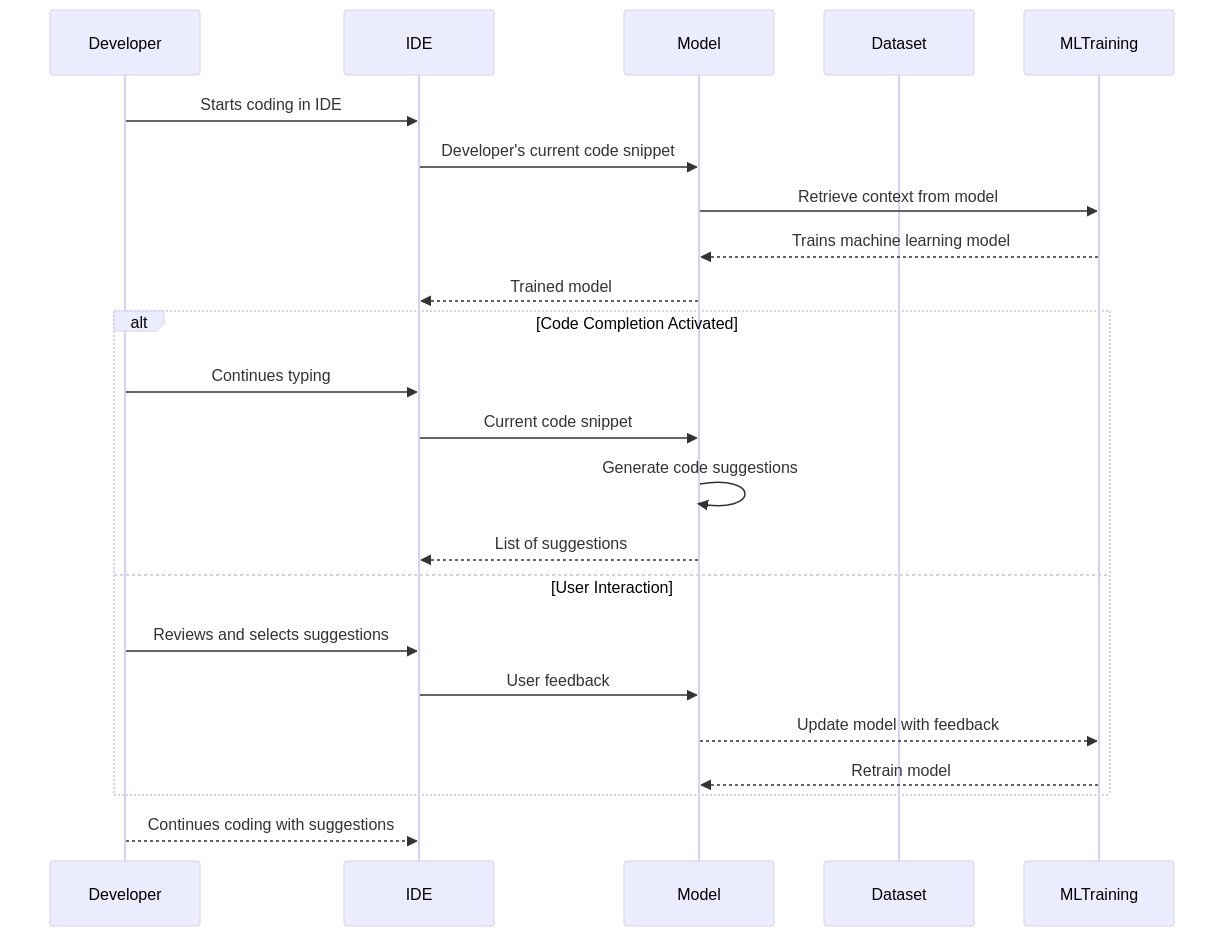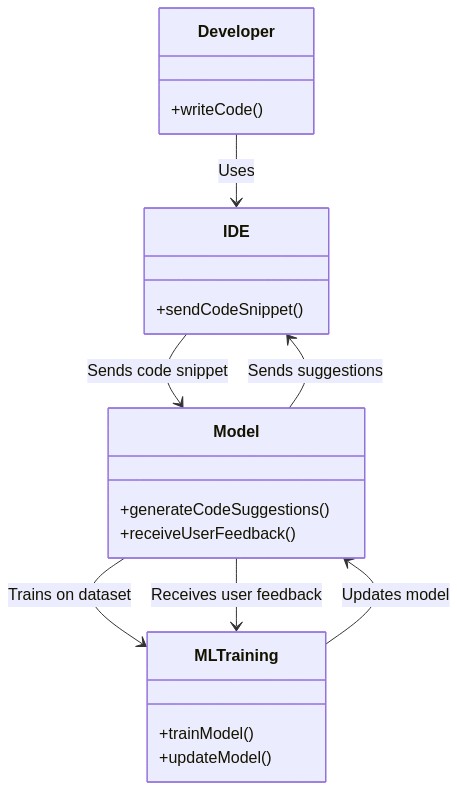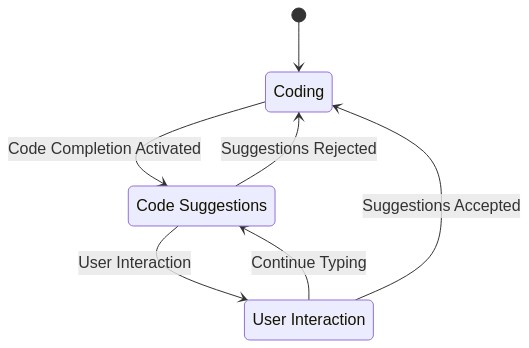import base64
from IPython.display import Image, display
import matplotlib.pyplot as plt
def mm(graph):
graphbytes = graph.encode("utf8")
base64_bytes = base64.b64encode(graphbytes)
base64_string = base64_bytes.decode("ascii")
display(Image(url="https://mermaid.ink/img/" + base64_string))UML Diagrams
Sequence Diagram
The sequence diagram that follows shows how the developer, IDE, model, and training process interact with one another. The process begins with the developer writing code in the IDE, the IDE sending the model the current code snippet, and the model using the machine learning model it has been trained to produce recommendations. After that, the developer can engage with the recommendations and offer input that helps the model get better over time by periodically retraining it. As the developer integrates the recommendations into their code, the process proceeds.
mm("""
sequenceDiagram
participant Developer
participant IDE
participant Model
participant Dataset
participant MLTraining
Developer->>IDE: Starts coding in IDE
IDE->>Model: Developer's current code snippet
Model->>MLTraining: Retrieve context from model
MLTraining-->>Model: Trains machine learning model
Model-->>IDE: Trained model
alt Code Completion Activated
Developer->>IDE: Continues typing
IDE->>Model: Current code snippet
Model->>Model: Generate code suggestions
Model-->>IDE: List of suggestions
else User Interaction
Developer->>IDE: Reviews and selects suggestions
IDE->>Model: User feedback
Model-->>MLTraining: Update model with feedback
MLTraining-->>Model: Retrain model
end
Developer-->>IDE: Continues coding with suggestions
""")
Class Diagram
The primary components and their interactions in an intelligent code completion system are depicted in this class diagram, which also emphasizes the information flow between the training component, the machine learning model, the integrated development environment, and the developer. However they might now reflect same in the code as we might change them according to the need.
mm("""
classDiagram
class Developer {
+writeCode()
}
class IDE {
+sendCodeSnippet()
}
class Model {
+generateCodeSuggestions()
+receiveUserFeedback()
}
class MLTraining {
+trainModel()
+updateModel()
}
Developer --> IDE: Uses
IDE --> Model: Sends code snippet
Model --> MLTraining: Trains on dataset
Model --> IDE: Sends suggestions
Model --> MLTraining: Receives user feedback
MLTraining --> Model: Updates model
""")
State Machine Diagram
The system is shown in the state machine diagram as “Coding” upon startup. It changes to the “Code Suggestions” state when code completion is enabled. In the event that the user interacts with the suggestions, the system can either move to the “User Interaction” stage or revert to the “Coding” state. The “User Interaction” state permits the developer to type further or approve/disapprove recommendations.
mm("""
stateDiagram
state "Coding" as Coding
state "Code Suggestions" as Suggestions
state "User Interaction" as Interaction
[*] --> Coding
Coding --> Suggestions: Code Completion Activated
Suggestions --> Coding: Suggestions Rejected
Suggestions --> Interaction: User Interaction
Interaction --> Suggestions: Continue Typing
Interaction --> Coding: Suggestions Accepted
""")
User Journey Diagram
The steps a developer takes to use the intelligent code completion system and get started with coding in the IDE are shown in this user journey diagram. Code completion, suggestion creation, user interaction, and the loop of continual improvement via user feedback and model retraining are all included.
mm("""
journey
title Developer's Journey with Intelligent Code Completion
section Getting Started
Developer --> IDE: Starts coding in IDE
section Code Completion Activated
IDE --> Model: Developer's current code snippet
Model --> MLTraining: Retrieve context from 70GB C code dataset
MLTraining -->> Model: Train machine learning model
Model -->> IDE: Trained model
Developer --> IDE: Continues typing
section Suggestions
IDE --> Model: Current code snippet
Model --> Model: Generate code suggestions
Model -->> IDE: List of suggestions
Developer --> IDE: Reviews and selects suggestions
section User Interaction
IDE --> Model: User feedback
Model -->> MLTraining: Update model with feedback
MLTraining -->> Model: Retrain model
Model -->> IDE: Updated model
Developer --> IDE: Continues coding with suggestions
section Conclusion
Developer --> IDE: Finishes coding
""")